Reptile & Amphibian
News Blog
Keep up with news and features of interest to the reptile and amphibian community on the kingsnake.com blog. We cover breaking stories from the mainstream and scientific media, user-submitted photos and videos, and feature articles and photos by Jeff Barringer, Richard Bartlett, and other herpetologists and herpetoculturists.
Tuesday, March 31 2015
By
Tue, March 31 2015 at 06:06
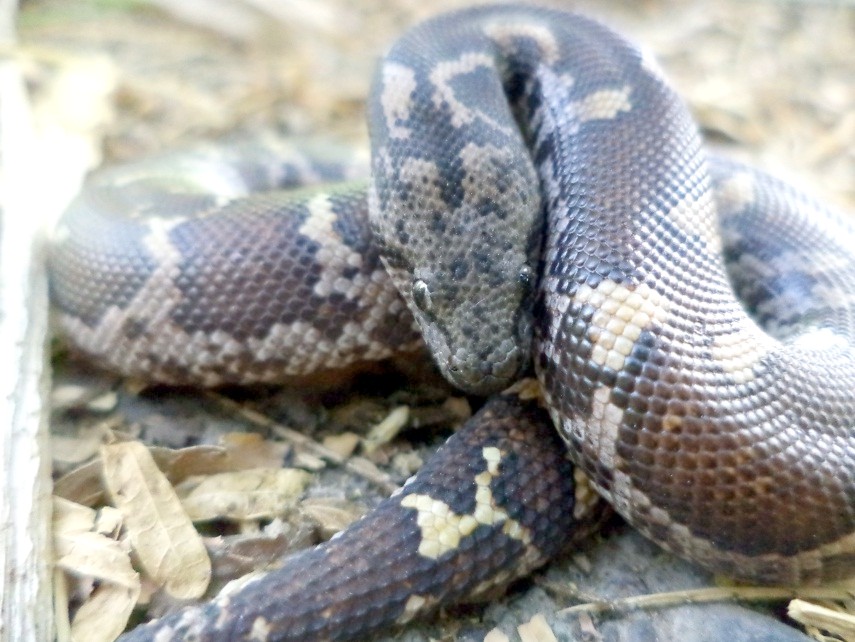 There are many snake lovers all over the world who love pythons and boas, and since I've been writing for kingsnake.com, many of them have contacted me to ask that I write about Indian pythons and boas. So this post is for my python and boa-loving readers!
In India, you can find all kinds of snakes, from the smallest 20 cm worm snake to the largest reticulated pythons, from sea snakes to flying snakes.
India is home to three species of sand boa, and the common sand boa, Gongylophis conicus, is one I frequently encounter on rescue calls. The other two are the red sand boa (Eryx johnii) and the Whitaker’s sand boa (Eryx whitakeri), which is named after the renowned Indian herpetologist Romulus Whitaker.
The common sand boa is also called the rough-scaled sand boa because of its rough, scaled body. If you’re a touching a common sand boa’s tail you can get a feeling of rubbing a crocodile's back.
A common sand boa’s body is thick and fat. It has small, keeled scales on head, and the tail is short, blunt and rough. Eyes are small with vertical pupils, and nostrils are placed high on the head. Ventral scales are narrower than the width of the body. It is sand coloured or brown with darker brown blotches. The old time rescuers who did not have a book or Internet to refer to used to mistake it for a young Indian rock python or Russell’s viper.
Found in sandy areas, it prefers to live in crevices and burrows. A short-tempered snake, it coils and hides its head under its body when disturbed, and when provoked strikes with a jerky movement. Otherwise, it's a slow moving snake. 100 cm is the maximum length. Sand boas are viviparous by nature.
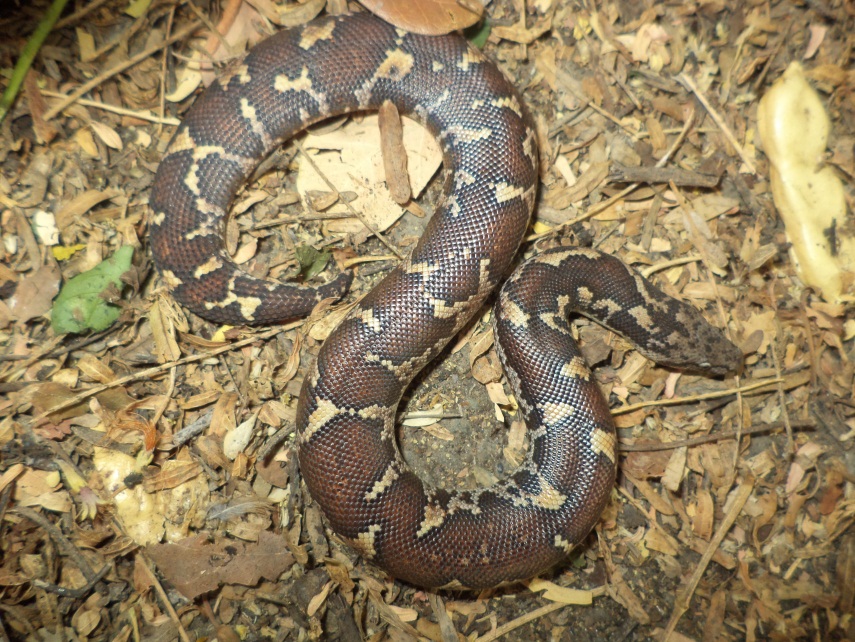
Once I had rescued a female adult sand boa snake and was carrying it in a snake sack to the releasing area . When I opened the sack to release this snake, I see to my surprise she had given birth to eight young ones! They were so cute and fat, as if they were working out in their mom’s womb. It was really a new and unforgettable experience.
One of the turtle species that Ron and I encountered on the Colima trip was a semi-aquatic creature of primarily terrestrial habits. Known as the Mexican spotted wood turtle, the subspecies we happened across was Rhinoclemmys rubida perixantha, the more northerly of the 2 known forms.
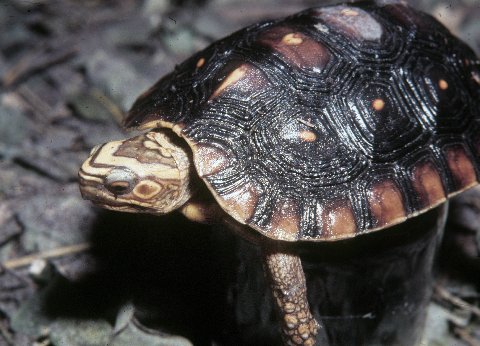
We encountered 3 of this (as we later learned) uncommon little chelonian. All of these little brown turtles seen were active at night in a flooded field just east of the city of Colima.
The most conspicuous things about these turtles were the intricate and busy head patterns of broad, dark edged, yellow bars and spots. Although the yellow head patterns precluded R. rubida being mistaken for R. pulcherrima, at 6 to 8 inches in length the former were also of smaller size.
Very little is yet known about the diet of the Mexican spotted wood turtle. It is thought that like others in the genus the species eats a good amount of vegetable matter and is an opportunist feeder on invertebrates. It is known that captives relish worms, caterpillars, and land dwelling molluscs.
Hopefully, as the Behler Center works with their group we will learn more about this beautiful and delightful turtle.
Monday, March 30 2015
By
Mon, March 30 2015 at 05:44
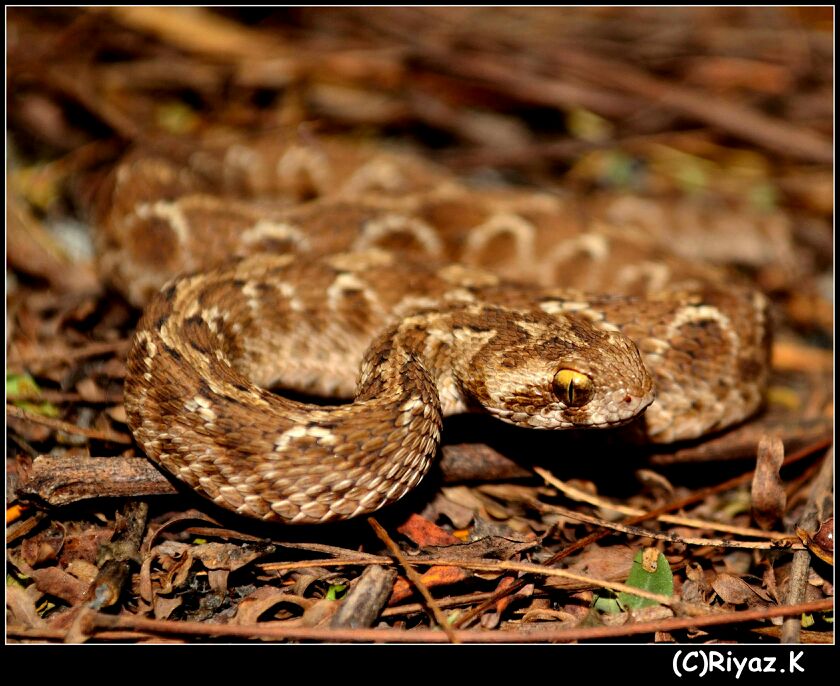 The saw-scaled viper, Echis carinatus, is a venomous snake found in India and the smallest member of the Indian "Big Four" deadly snakes of India.
This pygmy snake is one of the fastest-striking snakes in the world, and definitely the fastest striking one in India. The thing I like best about this tiny creature is that when the saw-scaled viper is disturbed, it coils and rubs its saw-like scales together to make a noise like a wood-saw.
They are hemotoxic by nature as they are from viper family.
Another species of saw-scaled viper found in India is the Sochurek’s saw-scaled viper, Echis carinatus Sochureki, which is found in some western and central parts of India.
The saw-scaled viper's body is pale brown with a white-bordered zig zag pattern. The body is white underneath with tiny brown spots. Small scales are present on head, and a white or pale brown spear mark on top.
The eyes are large golden with vertical black pupils, and the body is rounded and has scales with saw-like keels. The tail is short.
Saw-scaled vipers are commonly seen in coastal areas and they are found under boulders and thorny bushes. Though nocturnal, they may be seen basking in the morning. They feed on scorpions, centipedes, and geckos. Viviparous by nature, they give birth to 4-8 young ones.
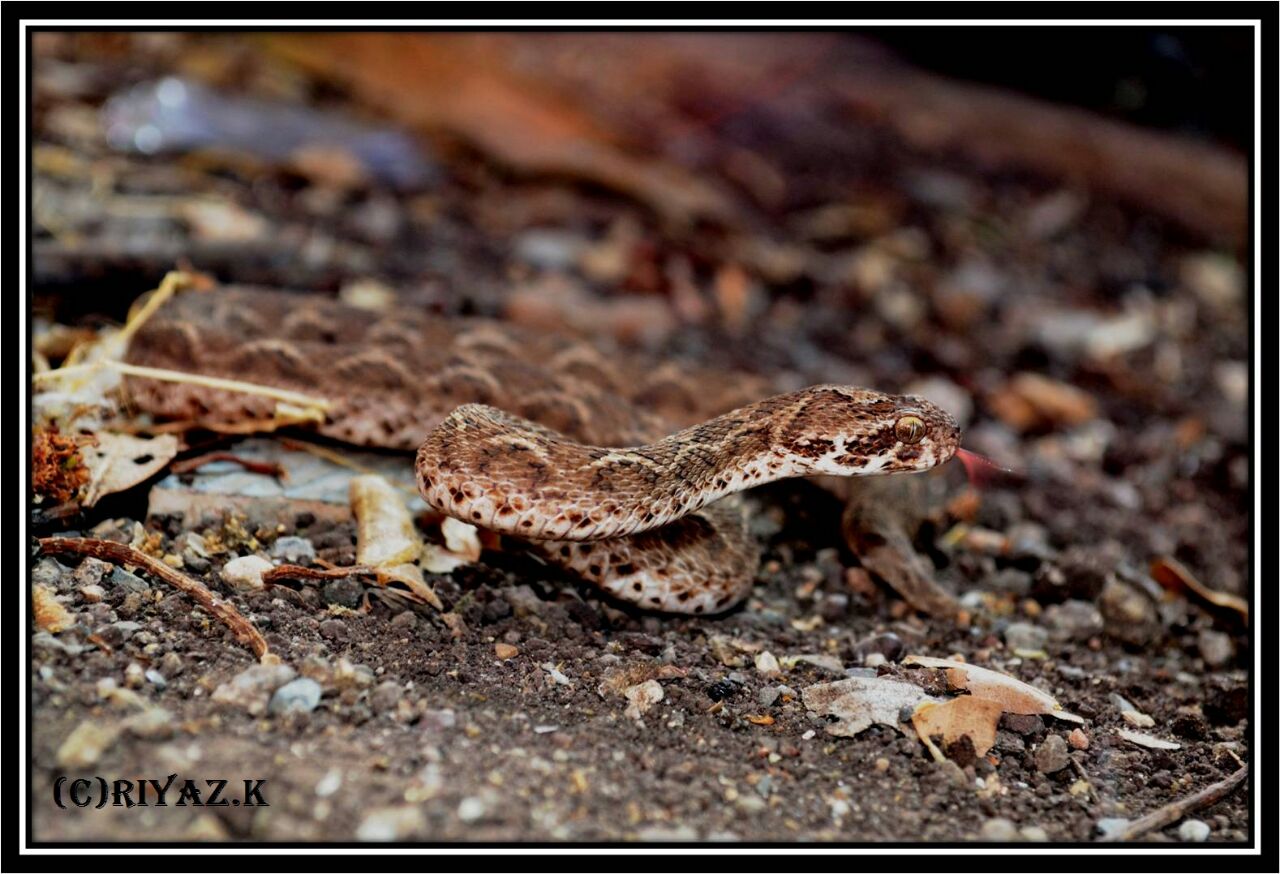
Usually there are few saw-scaled vipers in my area, but whenever I find one while herping, I am eager to hear the wood-saw noise. I find these tiny creatures very beautiful and attractive, but I always avoid bare-hand handling them.
Thursday, March 26 2015
In his little Austin Healey Sprite, Ron and I zipped across the border in Brownsville, Texas heading into Mexico's interior. We had no idea where we were going or where we would stop. We were young, had enough time and hoped we had sufficient dinero to get us to wherever and back home again. We did. Barely.
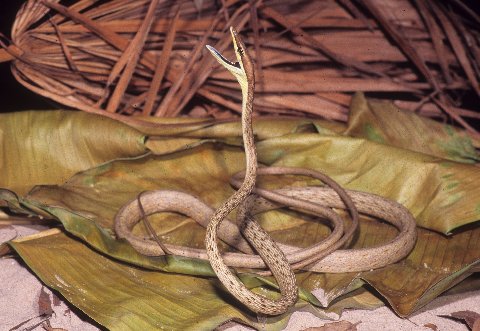
As it turned out we encountered torrential rains in the Pacific Coast state of Colima, and with the rains there were herps--herps of kinds we had never seen before in the wild, and many that neither of us had seen anywhere.
The rain flooded low lying fields and now treefrogs of a half dozen species were vocalizing. Mexican wood turtles walked the wet roadsides and swam across larger flooded areas. Lyre snakes, parrot snakes, and our hands down favorite - brown vine snakes - were crossing or sitting quietly on the highway. We were surprised that the latter were active as they are considered diurnal species with poor night vision but it seemed probable that the heavy rains prompted divergence from the norm.
Although Ron and I were known for unplanned trips, this one was by far the longest yet (a longer trip, it too, unplanned, to southern Chiapas was to come later). This multi-thousand mile trip for 2 adults in a 2-seat Sprite from Tampa to coastal southern Colima was more than just a bit crowded. But now, 50 years later, I still look back on with fond memories.
Wednesday, March 25 2015
By
Wed, March 25 2015 at 06:16
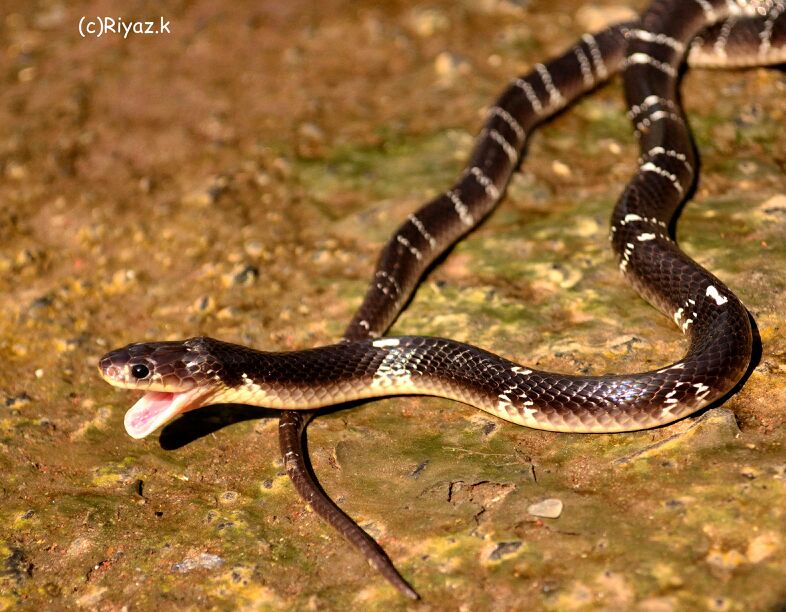 The common krait, Bungarus caeruleus, is a venomous snake found in India -- one of the four deadliest snakes of India known as "The Indian Big Four."
The krait is also included in the top five deadliest of the world, in part because of its silent killing ability. When a person is bitten by a krait, he or she won't feel pain because of the small-sized fangs; the bite pain is like a mosquito bite.
The common krait is a nocturnal snake; the kraits I rescued have all been rescued after 8 PM. It's difficult to find a snake during daytime rescue calls.
India is home to six or seven species of krait, and they're and also common in Pakistan, Sri Lanka, and many other Asian countries. The bite rate for the common krait is lower in India as compared to cobras and Russells vipers because kraits are very shy by nature and usually do not bite. That is the reason I love them.
Kraits have smooth bodies and glossy scales; they are blue or black in color and sometimes dark brown. There are single or paired thin white bands on the shiny black body, which makes them more beautiful and is the reason I use the 'Black Beauty' to describe a common krait.
The ventral part is white and sometimes yellowish. They feed on snakes mostly and sometimes even other kraits. Occasionally they eat mice, frogs, and lizards. The average length of krait is 100-120 cms and the maximum length is 175 cms.
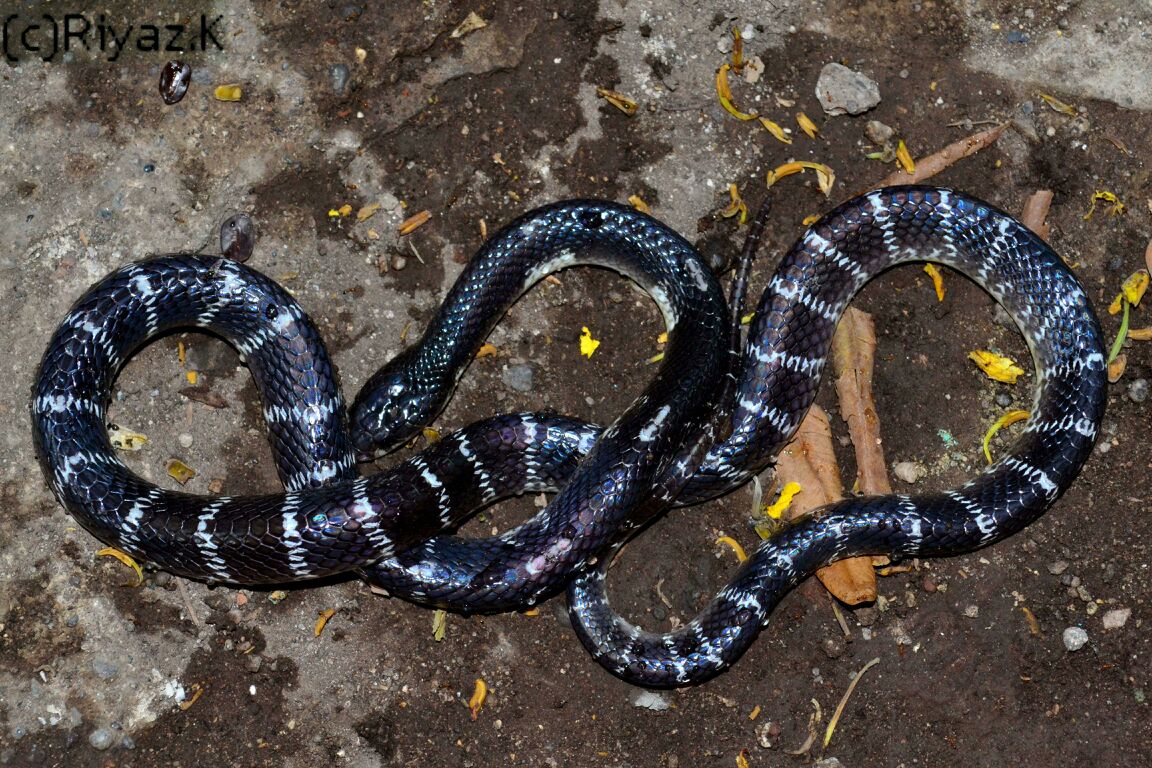
There are many controversies related to krait bite deaths in India. Often when people are bitten by a krait, it's night time and they don't realize it. And the symptoms of krait bite are not at all predictable. The symptoms might take 6 hours or even 48 hours to start. The symptoms have seven or eight stages leading up to death. The deadliest symptom is paralysis; the bite victim is not even able to move his or her fingertips. There have been cases where the victims were declared dead by doctors in the paralyzed condition.
Keeping the deadly part apart, I always loved kraits because they attacked me very rarely on rescue calls and always make my rescuing task easy.
Tuesday, March 24 2015
We spent only a few minutes flipping fallen palm fronds that lay on a grassy slope between a busy highway and a saltmarsh before we found the first of the several hatchling-sized ornate diamond-backed terrapins, Malaclemys terrapin macrospilota, we were to find that day.
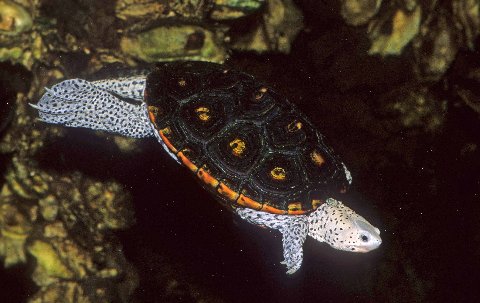
After seeing several of the turtle babies while he searched the area for kingsnakes, Billy pointed out this tract of roadside habitat to us and, sure enough, the turtles were here. All were beneath the fallen fronds and all were at least partially dug into the sandy substrate.
Although it had probably been several weeks since they had hatched, all that we found during our search were still of hatchling size, and all but 1 or 2 were quietly tucked in, legs and neck withdrawn, eyes tightly closed. Since we still had weeks of warm weather ahead of us, it seemed strange that so many babies were this quiescent.
But compared to Mother Nature, what do we know?
The ornate is the subspecies of diamond-backed terrapin that is found along most of Florida's Gulf Coast. It ranges from the northern Keys to Okaloosa County on the panhandle. Of the many subspecies, the ornate is most consistently the prettiest having a black flecked light gray head and usually an orange center to each carapacial scute. Hatchlings are particularly pretty and usually have very prominent vertebral tubercles.
Do not expect to see diamond-backs in freshwater habitats. They are restricted to salt and brackish waters.
Thursday, March 19 2015
The ringing peeps of a vocalizing ornate chorus frog, Pseudacris ornata, lack the upward slurring of the much more common spring peeper.
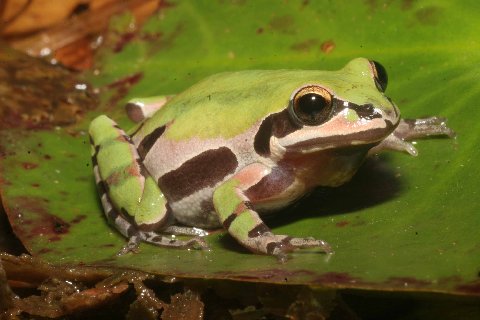
Although only one and one quarter inches in length, the ornate chorus frog, a heavy bodied species, looks larger. And this little frog of the southeastern United States, in some of its many colorations, is truly ornate. The ground color may vary from mud-brown, through russet, russet and green, to a clear pea green. There are often dorsal spots or stripes of a contrasting color. Black lateral and groin spotting is invariable and there is also a black eyestripe.
Despite its size, the ornate chorus frog can be perplexingly difficult to locate. It is ventriloquial to some degree, and a call that seems to be originating from close at hand may actually be originating from some distance away. On rare occasions, such as overcast, drizzly nights, ornate chorus frogs may sit on open muddy banks or float in the open while calling. But in most cases they call while tucked well away in tangles of blackberries or secluded in emergent grass clumps.
In some areas, such as its southernmost range on the Florida peninsula (the latitude of Lake Okeechobee), this frog is now present in reduced numbers (or extirpated). In fact, its current range in Florida may start well north of the Tampa Bay region. But in some more northerly areas it still seems common.
Take the time to look it up. It is a beautiful anuran.
Tuesday, March 17 2015
By
Tue, March 17 2015 at 06:08
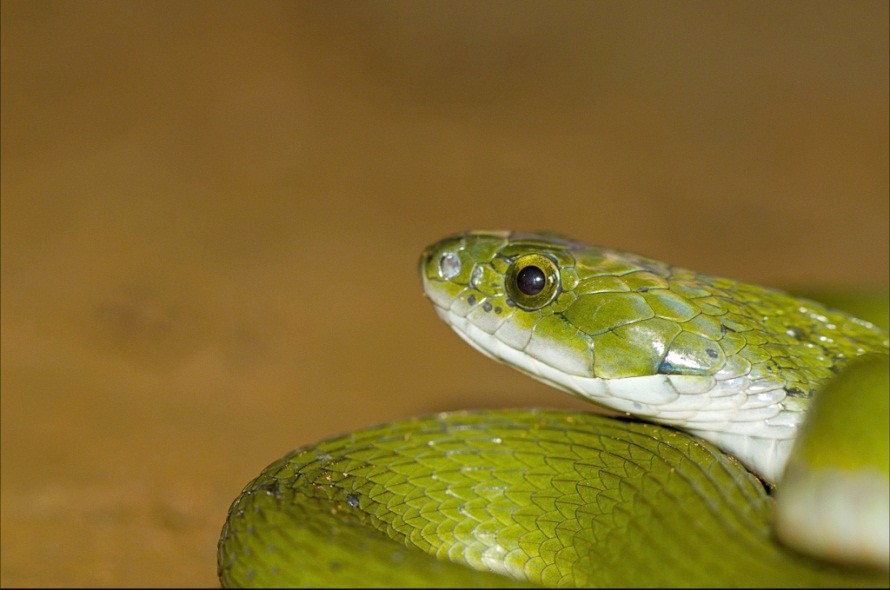 The grass snake, or green keelback, ( Macropisthodon plumbicolor) is a common snake found in india and a beautiful one indeed. As I mentioned in my previous vine snake post, I'm attracted to green-coloured snakes, so without any doubt I can call this one of my favourites.
Grass snakes are relatives of the familiar garter snakes found in the United States. Grass snakes are also called "green cobra" by few local rescuers in India because the young ones raise their hood like a cobra -- and trust me, they look awesome in that position.
When you hold a grass snake in your hand you can feel its rough scales, which are why it is called a keelback. Grass snakes are toad lovers, so I guess these snakes are more eager for rainy season than any other animal. The sad part about their toad-loving habit is that many times grass snakes have been seen eating larger toads as relative to their length, and they die due to over-consumption of prey. Although grass snakes are non-venomous, their saliva is toxic to frogs and toads, so even if a frog or toad escapes from the mouth or jaws of a grass snake it will die in a short span of time.
The grass snake's body is green and stout with keeled scales and a short tail. It has large green golden eyes with black pupils. Adults are green in color and sometimes have white spots on the fore body. Young ones have a black inverted 'v' mark on the head, and blue-black bands on the body that disappear as the snake grows.
Grass snakes are found in grasslands and forests, and also in densely-populated cities like Pune. They are very shy and do not bite. I have never seen an aggressive green keelback, but it can be capable of giving a painful bite, although it rarely does. It is a viviparous snake and lays 6-7 eggs between March and June.
This was one of the snakes I used to handle during my early days of snake rescuing because it never used to bite and it helped me to elminate my fear of snakes. I'm always very grateful to these snakes.
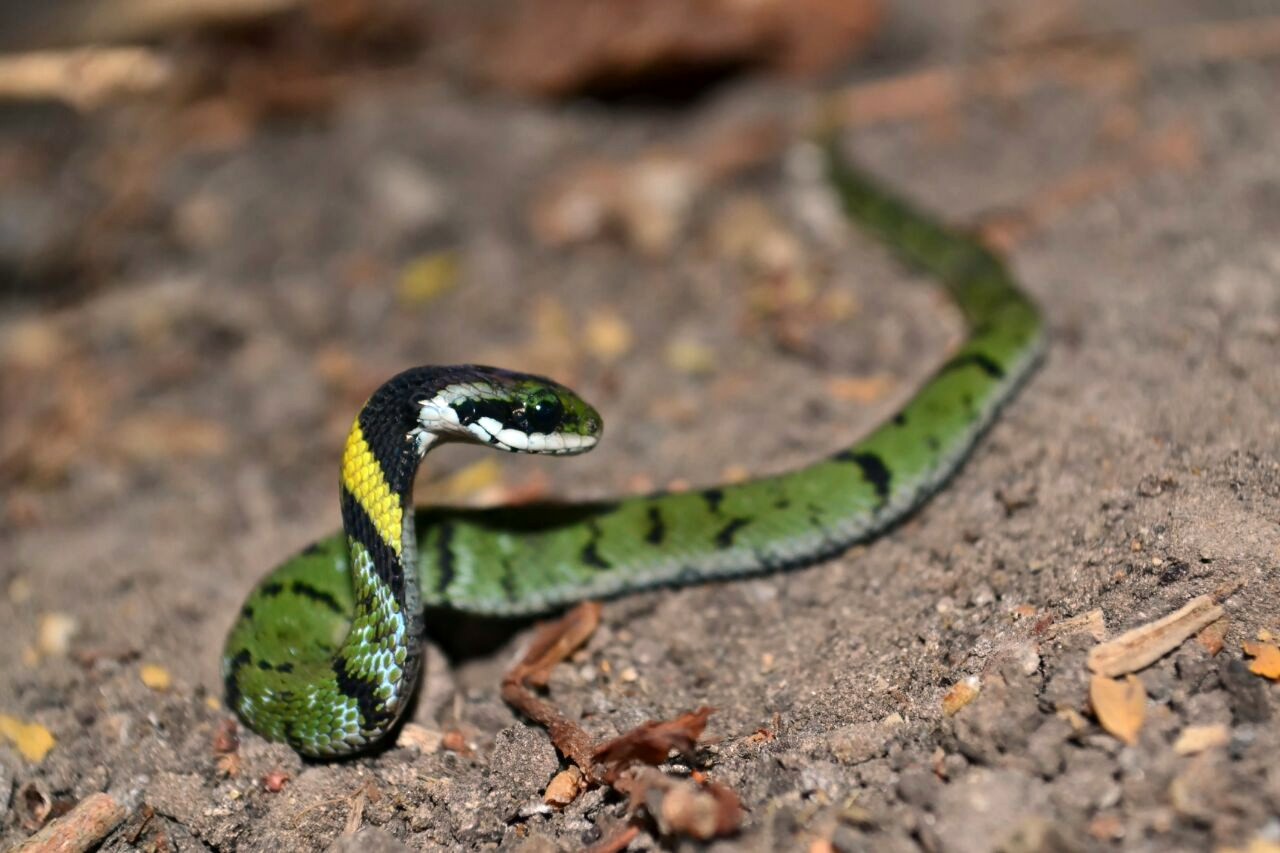
These elfin spirits of woodland and prairie care not whether you call them peepers, chorus frogs, or treefrogs. They are the various species of the genus Pseudacris, a genus comprised of about a dozen species.

They include in their ranks the smallest frog of the United States, the southeastern little grass frog, P. ocularis, that is adult at only 5/8ths of an inch and the giant of the genus, the Pacific treefrog, P. regilla, that may be a full 2 inches long.
The majority of the species, however are adult at about 7/8ths inch to about 1 1/8th inches in length. In other words, all are diminutive.
Most of the chorus frogs have a vocalization that sounds like a fingernail being run along the small teeth of a plastic pocket comb. The pulse rate is slower and the frog's color darker when temperatures are cold. The trill is faster and the colors brighter when the frog is warm. Those that don't have an apparent ratcheting trill produce peeps. Truth be told though, if the pulse rate of the peeps were slowed you would again be listening to a very apparent ratcheting.
Even where populations of chorus frogs are producing boisterous choruses, the little frogs, usually clad in camouflage colors and patterns, can be difficult to see. More often than not they position themselves in a clump of grasses emerging from the shallows of an ephemeral pond (or roadside ditch), nose pointing almost straight upward, and when so positioned are almost invisible. If searching, it is often the inflated and vibrating vocal sac that is most apparent.
Of all chorus frogs, spring peepers, P. crucifer, and little grass frogs are the most arboreal. They may call from almost any available vantage position from water's edge to several feet high in vegetation.
I wish you happy hunting and much luck as you search for these little frogs. You will probably need it.
Monday, March 16 2015
By
Mon, March 16 2015 at 06:17
In India, the ornate flying snake, Chrysopelea ornata, is also called the "ornamental flying snake" because of its unique and beautiful colour combination.

There are five species of flying snakes found around the world. All of them are found in Asian countries and belong to the chrysopelea family. India is home to two of those species: the ornate flying snake and the paradise flying snake ( Chrysopelea paradisii).
While the paradise flying snake is found in the eastern parts of India, the ornate flying snake is found in some parts of Maharashtra, Goa, and Karnataka, as well as some central and north eastern parts of India.
Many people think that this snake flies like a bird, but the truth is this snake does not fly, it glides from higher heights to lower heights. It is not able to fly from lower heights to higher.
I am seriously in love with the colour of this snake. Its body is greenish-yellow with black bands and red spots between the bands. The head is black with yellow bands on top. The underside is pale green. The size of the snake varies from 150-175 cms, and it is oviparous by nature.
I was the luckiest guy on the planet the day I found this snake while herping in the jungles of Karnataka with my friend Riyaz Khoja, a wildlife photographer and snake rescuer.
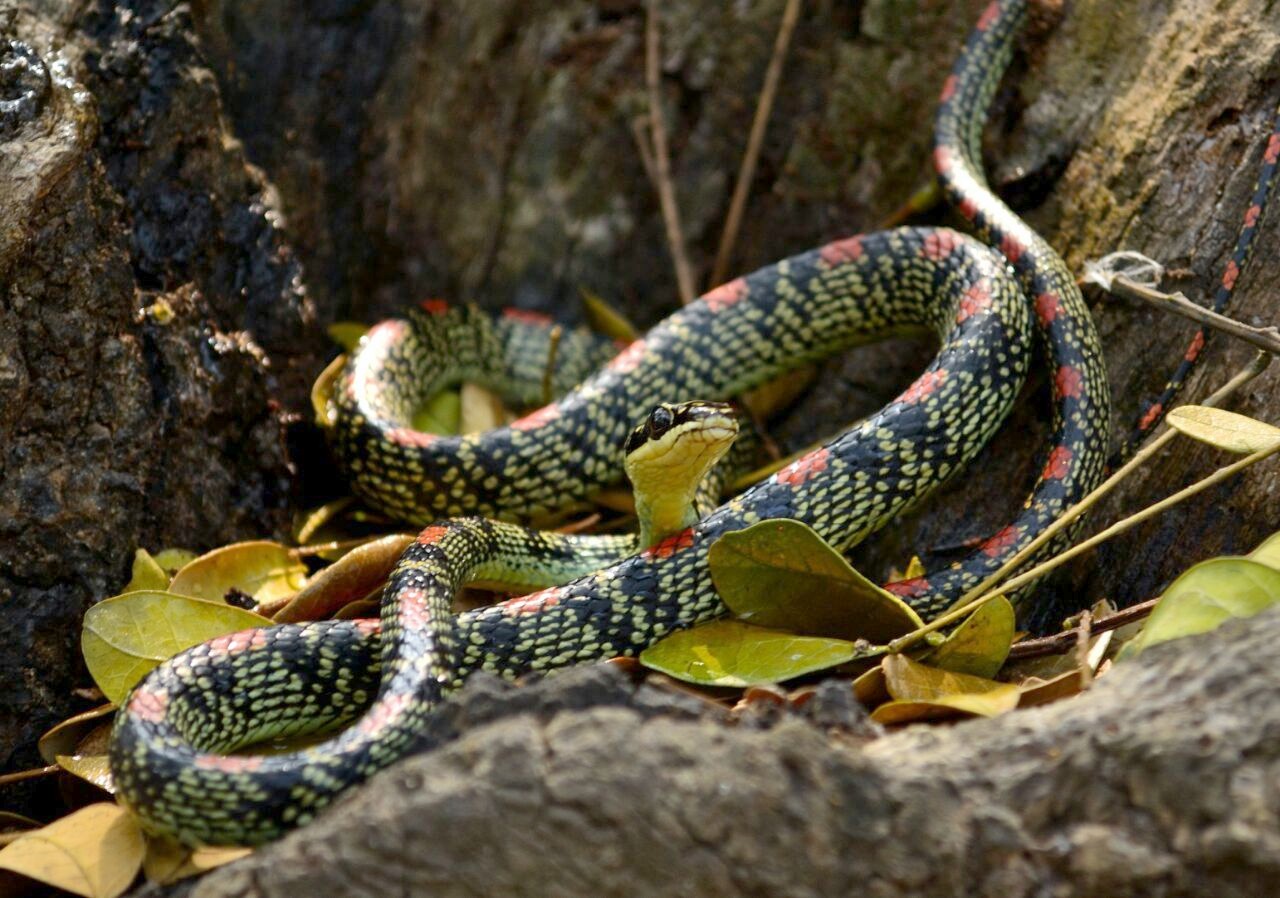
We were walking in the jungle around 8 AM and saw thin branches move like something had fallen on them. We ran to the tree and were surprised to see a good-sized ornate flying snake. I was so excited, I shouted like I had just won the lottery, and my voice echoed through the jungle.
We lifted the snake from the branches and kept him in a relaxed position on the tree. After Riyaz clicked these beautiful photographs, we left the snake where we found it.
The memory of finding this snake brings a smile to my face every time I think about it. There are not words enough to express how beautiful they are.
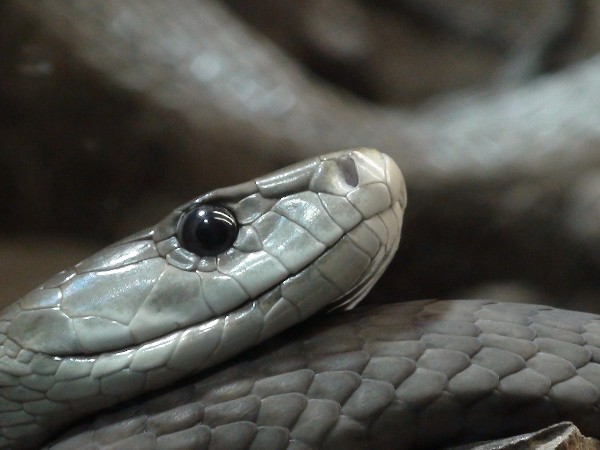 A soldier assigned to a Kenya naval station was killed last month by a venomous snake, reports military newspaper Stars and Stripes.
Pfc. Bailey Jerome Swaggart, 25, of the 4th Brigade, 1st Armored Division, died Feb. 19, a month after he was deployed to Manda Bay Naval Base. He was assigned to guard an air strip and got out of his Humvee to investigate a small brush fire nearby and was bitten.
The military treats more bite victims than many realize. According to a 2013 U.S. Army Research study , 17 cases of venomous snakebite, most in Afghans but including two U.S. service members, were brought to three U.S. military medical units in Afghanistan between 2010 and 2011; all survived after treatment. The median time between being bitten and receiving treatment was 2.8 hours.
East Africa has a wide variety of venomous snakes, including puff adders, cobras, vipers and mambas. Though it was unclear which type of snake killed Swaggart, it was thought to have been a viper or a black mamba.
We all know members of the military are exposed to the hazards associated with a war zone, things like snipers, ambushes, and IEDs. It may not always occur to us hey're also subject to the normal hazards of daily life, like car accidents, workplace accidents, and snake and insect bites. However, these dangers occur often enough to produce a significant casualty rate on their own, and often in areas of lesser or no conflict are the main cause of injury among service men and women.
To read more, check out the complete article on the Stars and Stripes website.
Black mamba photo by site user 1sun.
Thursday, March 12 2015
By
Thu, March 12 2015 at 08:21
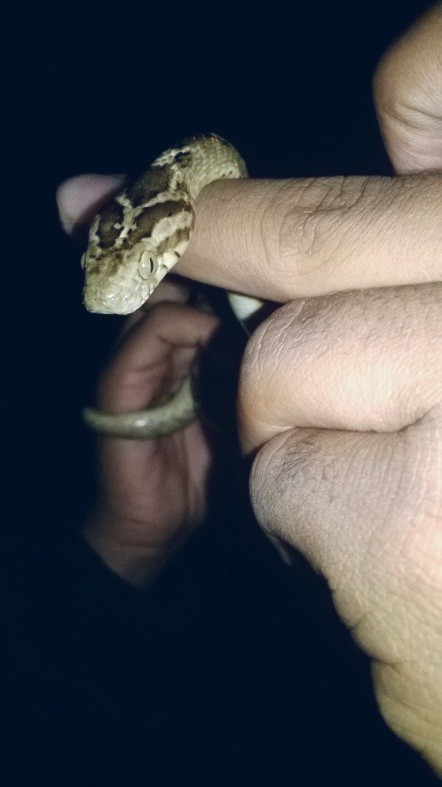 If someone asks me about my five favorite Indian snakes, I would include the cat snake.
Cat snakes, Boiga trigonata, are the snakes I always like to hold in my hand and play with them. A cat snake is basically a tree snake, so it is a slow moving snake like many other tree snakes.The best thing I like about the cat snake is that, if I hold its tail upside down,bit will slowly slowly coil back to its regular position.
There are 7-8 species of cat snakes found in the Indian sub-continent.The common Indian cat snake is the most commonly found amongst other cat snakes. Cat snakes are semi-venomous snakes which are also called rear fanged snake. Cat snakes are found across the world and in many places they are named as cat-eyed snake because of their vertical eye pupils which ressembles a cat's eye.
The common Indian cat snake is long and thin, and the body and tail are slightly compressed. It has large head with large cat -ike eyes and vertical pupils.
Colour is light brown with darker brown zig-zag markings. There's a brown streak behind each eye. The ventral part is yellow or white with small spots. The size varies from 100-125cms in an adult. As it is a tree snake it is mainly found on trees and bushes in grassland. It is a shy natured snake and usually does not bite but, when it is disturbed, lifts head to strike and vibrates its tail. Common cat snakes feed on lizards, frogs, geckos, small birds, and mice. It is oviparous and lays 5-8 eggs in tree hollows and it is nocturnal in nature.
I never got a chance to rescue a cat snake as they prefer hilly and dense jungle areas and unfortunately I live in a city. For every time I go out on herping I wish I could find a cat snake, it's like looking for a diamond in a coal mine.
Continue reading "A cat that doesn’t meow: The common Indian cat snake"
There is in South Florida, a salt marsh in which dwell some of the prettiest mangrove saltmarsh snakes, Nerodia clarkii compressicauda, I have ever happened across.
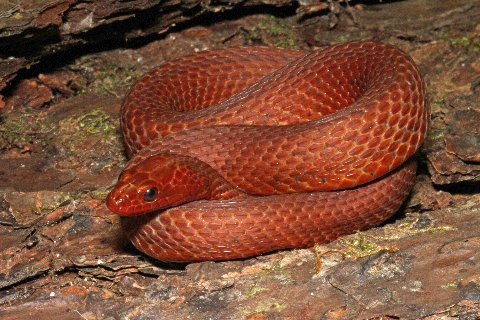
There are many, of course, that are rather run-of-the-mill, but there are some that are clad in scales that are the brightest red I have ever seen on a water snake.
Many evenings the search first turns up one or more mangroves that are the more traditional dull olive green with variably distinct dark markings that are also variable in shape--sometimes blotches, sometimes bands, and sometimes stripes. The latter, if present, usually on the neck and anterior body.
Although also variable, the red examples tend towards a solid, unpatterned color, be it a rather pale orange red, a medium red, or the bright red, the phase I search most eagerly for, for no reason other than I enjoy seeing it.
As an entity, mangrove salt marsh snakes are fairly common in coastal areas along the southern two-thirds of the Florida peninsula and the Keys. The farther north in their range you find them, the more apt they are to be of grayish ground color and have broken dark striping. At the northernmost end of the range on both coasts, there is a intergradation with the subspecies next northward. That is the Gulf salt marsh snake, N. c. clarkii on the Gulf Coast and the Atlantic salt marsh snake, N. c. taeniata, on the Atlantic Coast.
Tuesday, March 10 2015
Many, many, years ago when I first saw a photo of Elaphe situla (now Zamenis situla) I did a double take. Although it was captioned "Leopard Rat Snake," at first glance (and even at second glance) it sure looked like a corn snake.
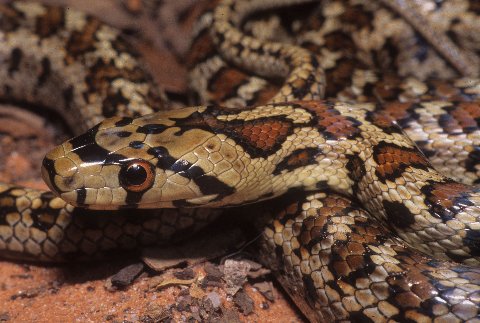
Eventually I was lucky enough to see a leopard rat snake and to learn there are two distinctly different patterns, a saddled and a striped. Later still, I acquired a pair of each phase and bred the taxon. I learned that despite the similarity of the saddled phase to our corn snake the slender, Old World, leopard rat snake was and is quite unlike the New World species.
Please allow me to introduce you.
First, although often referred to as a European taxon, the leopard rat snake is actually Eurasian in distribution. This snake has a ground color of warm brown to gray and, depending on the phase, either a pair of dark-edged red stripes or neck-to-tail irregular dark bordered red saddles.
Both phases have a row of prominent black spots along each side. A dark interocular crescent is present as are other dark markings on neck and face. The venter varies from being nearly solid black to being light with black checkers. This scrubland snake is adult at a slender 2 to 3 feet in length.
I was told that captive bred examples will feed readily on suitably sized lab mice. Those I had, though, were wild caught and refused lab mice, but readily accepted wild mice of the genus Peromyscus (white-footed and cotton mice). To comply with their tastes we began a breeding program of the desired mouse species. This was a bit time consuming but proved well worth the effort. The snakes thrived, bred, and as I had been told the hatchlings did indeed feed readily on pinky lab mice.
Monday, March 9 2015
 Reptile rescues need the community's support now more than ever. With the recent addition of the the reticulated python and all species of anaconda to the injurious species list, rescues will lose a large adoption and placement pool.
I have operated my rescue for 21 years now, and for much of that time I have relied on my friends to the south to assist when I had giant species. Depending on what I have in the rescue at any given time, I may need to call upon my Illinois friends to take even a large boa constrictor. Thankfully, I still have that outlet for boas, but at the end of our 30-day grace period, I will lose that ability with retics and all anacondas. Crossing state lines with those species will no longer be legal, and working with my partners in Illinois would make me an instant felon. I am not alone in this; there are rescues across the country that will need assistance from our community.
As the community rallies behind USARK in the upcoming battle to remove these species from the list, it would be wonderful if those of you who have the ability to own one of the restricted species would take this moment and reach out.
Contact your local herp society, which undoubtably runs a rescue program, as well as local reptile rescues to let them know you are willing to help.
Need help locating a rescue near you? Please post in the comments or check out our rescue listing located here.
Friday, March 6 2015
 An inaccurate report published last night in the Miami Herald set the stage for bad news, but while today the USFWS has chosen not to list the boa constrictor as an invasive species at this time, they did list the reticulated pythons and three species of anaconda.
A press release issued today by the service stated:
"The U.S. Fish and Wildlife Service (Service) today declared the reticulated python, DeSchauensee’s anaconda, green anaconda and Beni anaconda as “injurious” under the Lacey Act. A fifth snake, the boa constrictor, is removed from consideration for listing as an injurious wildlife species.
The listing will prohibit import of the four snakes into the United States and its territories, as well as transport across state lines for snakes already in the country, and is intended to help restrict the snakes’ spread in the wild. Following opportunities for public comment, an economic analysis and an environmental assessment, the Service produced the final rule, which is expected to publish in the Federal Register March 10. The prohibitions in the rule will go into effect 30 days after publication and apply to live individuals, gametes, viable eggs or hybrids of the four snakes."
To read the complete press release, click here.
Photo: kingsnake.com user Steve Ray
Thursday, March 5 2015
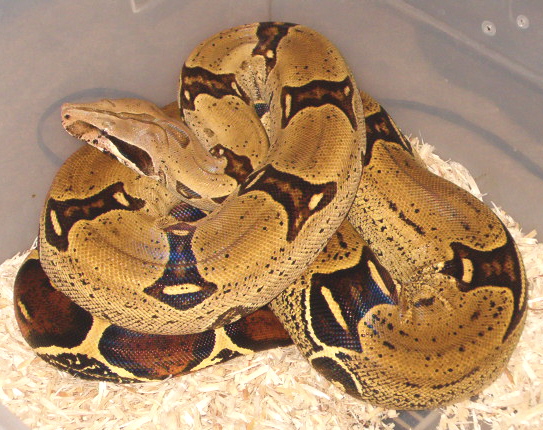 The US Fish & Wildlife Service will be adding boa constrictors, reticulated pythons, and anacondas to the invasive species restricted list, banning their import and interstate transport, reports the Miami Herald. On Friday, agency director Dan Ashe will make the announcement in Florida at at the Arthur R. Marshall Loxahatchee National Wildlife Refuge in Boynton Beach.
This is not likely to end the long fight between the USFWS and the reptile community, begun in 2006 when the ban was first proposed and the subject of an ongoing lawsuit by the United States Association of Reptile & Amphibian Keepers (USARK). While it is expected to impact the industry, many states will see legal local sales of restricted animals continue, so the overall impact is unclear.
For more information, check out the complete story at the Miami Herald.
Photo: kingsnake.com user Dewback
Known as the one hundred pacer to some, a graphic reference to the supposed efficacy of the venom (one bite and you're dead in 100 paces or less!) and the snorkel-nosed viper to others, Deinagkistrodon acutus is one of the most recognizable and photogenic of the Asian snakes.
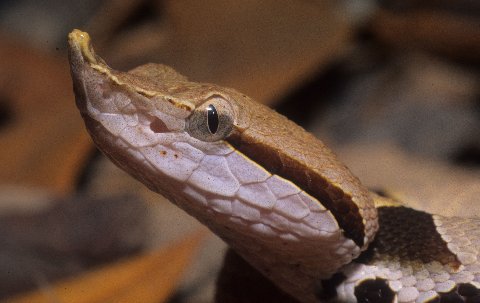
Having a light ground color, the dark triangular pattern is boldly evident--unless the snake is lying quietly coiled on a substrate of variably colored leaves. Then the camouflaging benefits of the pattern will be truly appreciated.
Adults of this oviparous crotaline may near a heavy bodied 5 feet in length. Hatchlings are a relatively slender 8 inches. A clutch typically numbers between 10 and 25 eggs, but up to 35 have been documented.
Prey items of this crepuscular and nocturnal snake include amphibians, small ground nesting or ground active birds and rodents.
Ranging over much of southern China and northern Vietnam, this taxon is of cultural significance in many areas, among which Taiwan is prominent.
Tuesday, March 3 2015
It was late spring, in the Apalachicola National Forest (ANF) and I happened to have an hour to kill before meeting Kenny for a couple of days of herping. I was within a few miles of a favorite puddle, so decided to stop by for a hurried visit. During the winter this bit of water was a breeding site for ornate chorus frogs, I had seen a banded water snake or two there, and in previous years had seen a few mole salamanders beneath water edge logs.
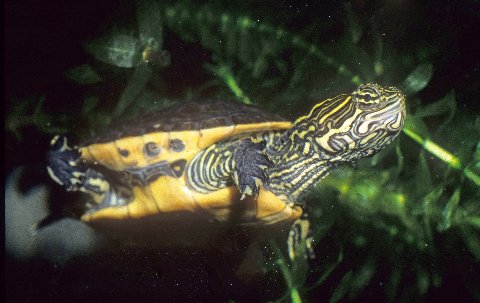
But this time when I pulled up the site was unrecognizable. We had had an unusually wet winter and the rains had continued into the spring. The site, including the road-edge drainage ditch, was filled and overflowing with water. For a moment or two I contemplated whether I wanted to get wet just before leaving on a trip. But then a turtle surfaced in the flowing water of the ditch--a turtle with a narrow head and a prominently striped neck-- an eastern chicken turtle, Deirochelys r. reticularia.
Unlike many of their semi-aquatic emydine stay-at-home relatives, the chicken turtles (3 subspecies) are known for their peregrinations. These turtles wander widely from flooded meadow to vernal pond to the still waters of canal edges. If things get uncomfortably dry they dig down and aestivate. And although I consider them one of the "everywhere and nowhere" turtles (meaning they are widespread but seldom readily seen), they are seen infrequently enough to consider each sighting a mini-event.
So now, if you have interpreted the last paragraph correctly, you know I wasn't about to leave without at least trying to get some data from the chicken turtle. Yep. I got wet, but I was able to catch the turtle, a perfect example, an adult male. Hopefully he is still wandering, stopping now and again to sire more generations of wandering turtles. They are a delight to see.
|



